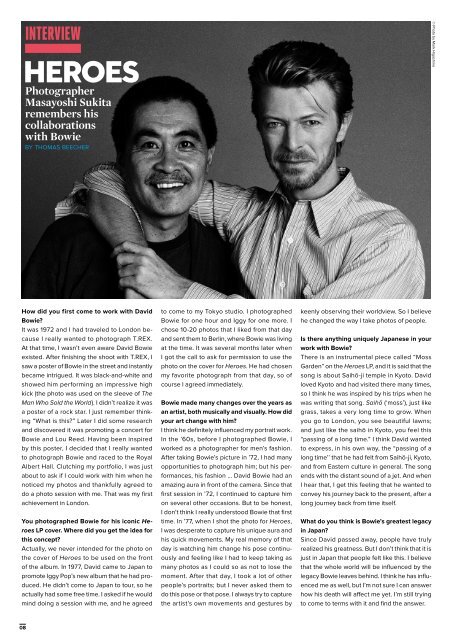DAVID BOWIE
1lVsfhZ
1lVsfhZ
You also want an ePaper? Increase the reach of your titles
YUMPU automatically turns print PDFs into web optimized ePapers that Google loves.
INTERVIEW<br />
HEROES<br />
Photographer<br />
Masayoshi Sukita<br />
remembers his<br />
collaborations<br />
with Bowie<br />
BY THOMAS BEECHER<br />
© Photo by Mark Higashino<br />
How did you first come to work with David<br />
Bowie?<br />
It was 1972 and I had traveled to London because<br />
I really wanted to photograph T.REX.<br />
At that time, I wasn’t even aware David Bowie<br />
existed. After finishing the shoot with T.REX, I<br />
saw a poster of Bowie in the street and instantly<br />
became intrigued. It was black-and-white and<br />
showed him performing an impressive high<br />
kick (the photo was used on the sleeve of The<br />
Man Who Sold the World). I didn’t realize it was<br />
a poster of a rock star. I just remember thinking<br />
“What is this?” Later I did some research<br />
and discovered it was promoting a concert for<br />
Bowie and Lou Reed. Having been inspired<br />
by this poster, I decided that I really wanted<br />
to photograph Bowie and raced to the Royal<br />
Albert Hall. Clutching my portfolio, I was just<br />
about to ask if I could work with him when he<br />
noticed my photos and thankfully agreed to<br />
do a photo session with me. That was my first<br />
achievement in London.<br />
You photographed Bowie for his iconic Heroes<br />
LP cover. Where did you get the idea for<br />
this concept?<br />
Actually, we never intended for the photo on<br />
the cover of Heroes to be used on the front<br />
of the album. In 1977, David came to Japan to<br />
promote Iggy Pop’s new album that he had produced.<br />
He didn’t come to Japan to tour, so he<br />
actually had some free time. I asked if he would<br />
mind doing a session with me, and he agreed<br />
to come to my Tokyo studio. I photographed<br />
Bowie for one hour and Iggy for one more. I<br />
chose 10-20 photos that I liked from that day<br />
and sent them to Berlin, where Bowie was living<br />
at the time. It was several months later when<br />
I got the call to ask for permission to use the<br />
photo on the cover for Heroes. He had chosen<br />
my favorite photograph from that day, so of<br />
course I agreed immediately.<br />
Bowie made many changes over the years as<br />
an artist, both musically and visually. How did<br />
your art change with him?<br />
I think he definitely influenced my portrait work.<br />
In the ’60s, before I photographed Bowie, I<br />
worked as a photographer for men’s fashion.<br />
After taking Bowie’s picture in ’72, I had many<br />
opportunities to photograph him; but his performances,<br />
his fashion … David Bowie had an<br />
amazing aura in front of the camera. Since that<br />
first session in ’72, I continued to capture him<br />
on several other occasions. But to be honest,<br />
I don’t think I really understood Bowie that first<br />
time. In ’77, when I shot the photo for Heroes,<br />
I was desperate to capture his unique aura and<br />
his quick movements. My real memory of that<br />
day is watching him change his pose continuously<br />
and feeling like I had to keep taking as<br />
many photos as I could so as not to lose the<br />
moment. After that day, I took a lot of other<br />
people’s portraits; but I never asked them to<br />
do this pose or that pose. I always try to capture<br />
the artist’s own movements and gestures by<br />
keenly observing their worldview. So I believe<br />
he changed the way I take photos of people.<br />
Is there anything uniquely Japanese in your<br />
work with Bowie?<br />
There is an instrumental piece called “Moss<br />
Garden” on the Heroes LP, and it is said that the<br />
song is about Saihō-ji temple in Kyoto. David<br />
loved Kyoto and had visited there many times,<br />
so I think he was inspired by his trips when he<br />
was writing that song. Saihō (‘moss’), just like<br />
grass, takes a very long time to grow. When<br />
you go to London, you see beautiful lawns;<br />
and just like the saihō in Kyoto, you feel this<br />
“passing of a long time.” I think David wanted<br />
to express, in his own way, the “passing of a<br />
long time’’ that he had felt from Saihō-ji, Kyoto,<br />
and from Eastern culture in general. The song<br />
ends with the distant sound of a jet. And when<br />
I hear that, I get this feeling that he wanted to<br />
convey his journey back to the present, after a<br />
long journey back from time itself.<br />
What do you think is Bowie’s greatest legacy<br />
in Japan?<br />
Since David passed away, people have truly<br />
realized his greatness. But I don’t think that it is<br />
just in Japan that people felt like this. I believe<br />
that the whole world will be influenced by the<br />
legacy Bowie leaves behind. I think he has influenced<br />
me as well, but I’m not sure I can answer<br />
how his death will affect me yet. I’m still trying<br />
to come to terms with it and find the answer.<br />
08


